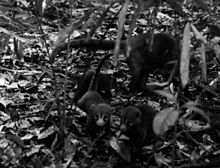- Nasua
-
Nasua[1] 
White-nosed Coati (Nasua narica) Scientific classification Kingdom: Animalia Phylum: Chordata Class: Mammalia Order: Carnivora Family: Procyonidae Genus: Nasua Species Nasua is a genus within the Raccoon family, Procyonidae. The three species within the genus Nasua are generally referred to as coatis. Two additional species of coatis, commonly known as mountain coatis, are placed in the genus Nasuella. Nasua differs from Nasuella in being larger and having larger canine teeth,[2] but preliminary genetic evidence suggests Nasuella should be merged into Nasua.[3] Other genetic studies have shown that the closest relatives of the coatis are the olingos (genus Bassaricyon).[4]
Like other procyonids,[5] coatis are omnivores. Their diet consists largely of insects, insect larvae, spiders and other invertebrates and the occasional small vertebrate discovered while energetically foraging, their sensitive noses to the ground, in forest leaf litter. On Barro Colorado Island, Panama, where they have been studied in greatest detail,[6][7] they supplement this diet with copious amounts of fruit as it becomes available seasonally from favored trees such as figs (Ficus insipida) and hog plums (Spondias mombin).
Their very active foraging behavior appears to be interrelated with their distinctive social organization. Exceptional among procyonids, coatis are diurnal and for much of the year gregarious. Though females nest, and bear and nurse their young in isolation, shortly after the altricial young become mobile the females aggregate into social groups known as bands. Bands consist of adult females (two or more years old), and sub-adults (1 – 2 years old) and juveniles (< 1 year old) of both sexes. At maturity at two years of age, males are excluded from bands and take up a solitary lifestyle. They are aggressively repelled from bands, except during the mating season when typically one male ingratiates himself to a band through submissive behavior, forages with it for a period of a few weeks, and mates with all of the adult females. During the nesting season, the sub-adults and juveniles remain together in bands while breeding adult females become solitary for parturition and nesting. Females begin breeding in their 3rd or 4th year, apparently depending on nutritional status. Occasionally older females become postreproductive, and these remain with the bands while breeding females separate. Breeding is synchronous, as is parturition and nursing. Resumption of gregarious behavior takes place synchronously as well, over the course of several weeks, depending on the existence of previous social relationships, i.e. females with prior relationships reaggregate into bands more quickly than those forming new relationships. Nonetheless, persistent social bonds may form anew at this point in the reproductive cycle – while there may be a tendency to reaggregate with kin, prior relationships are not indispensable. Previously unfamiliar individuals may aggregate into bands with stable social relationships. A conspicuous means of bond formation is mutual grooming, on which an hour or more may be spent daily. Some of this appears to be ritualized as a form of social bond formation (Fig. 1), though it is clearly mutually beneficial as well – the burden of ticks on band members is lower than it is on solitary adult males, for instance.[8]
When juveniles descend from the nest, they are little better than helpless (Fig. 2). One important benefit of aggregating for the adult females is sharing of vigilance in protection of juveniles from predation. Juvenile mortality is high, sources of peril including adult male coatis which have been observed to kill them.[9] It is not entirely clear whether adult males are preying on them or killing potential rivals, and of course it may be both. The active foraging behavior of coatis is fairly conspicuous, and requires a considerable degree of attention. The proportion of time that adult females spend foraging increases, and the proportion of foraging time interrupted for stationary vigilance behavior decreases, when aggregation into bands is achieved. Bands forage in formation, with adults and sub-adults distributed around the periphery, and juveniles gathered towards the center. This shared vigilance appears to be an important contributor to the benefit of gregariousness for coatis.
Species
The three species within Nasua are:
- N. narica (Linnaeus, 1766) - White-nosed Coati, Pizote, or Antoon (Southwestern United States, Mexico, Central America, Colombia and Ecuador)
- N. nasua (Linnaeus, 1766) - South American Coati (South America)
- N. noriathis (Mady, 1995) - Range Coati (Serra dos Órgãos, Brazil)
- N. nelsoni Merriam, 1901 - Cozumel Island Coati (Cozumel, Mexico)
References
- ^ "Mammal Species of the World". http://www.bucknell.edu/msw3/browse.asp?id=14001624. Retrieved 2007-07-14.
- ^ Emmons, Louise (1997). Neotropical Rainforest Mammals, A Field Guide, 2nd Edition. Chicago: University of Chicago Press. pp. 153–154. ISBN 0-226-20721-8. OCLC 35686100.
- ^ Helgen, K. M., R. Kays, L. E. Helgen, M. T. N. Tsuchiya-Jerep,, C. M. Pinto, K, P. Koepfli, E. Eizirik, and J. E. Maldonado (2009). Taxonomic boundaries and geographic distributions revealed by an integrative systematic overview of the mountain coatis, Nasuella (Carnivora: Procyonidae). Small Carnivore Conservation. 41: 65–74
- ^ K.-P. Koepfli, M. E. Gompper, E. Eizirik, C.-C. Ho, L. Linden, J. E. Maldonado, R. K. Wayne (2007). "Phylogeny of the Procyonidae (Mammalia: Carvnivora): Molecules, morphology and the Great American Interchange". Molecular Phylogenetics and Evolution 43 (3): 1076–1095. doi:10.1016/j.ympev.2006.10.003. PMID 17174109.
- ^ Patent, D. H. 1979. Raccoons, coatimundis and their family. Holiday House, New York
- ^ Kaufmann, J.H. 1962. Ecology and social behavior of the coati, Nasua narica on Barro Colorado Island, Panama. Univ. of California Publications in Zoology 60:95-222.
- ^ Russell, J.K. (1982) Timing of reproduction by coatis (Nasua narica) in relation to fluctuations in food resources. In: The Ecology of a Tropical Forest. Seasonal Rhythms and Long-term Changes. E.G. Leigh, Jr., A. S. Rand, D. M Windsor (eds). Smithsonian Inst. Press, Washington, D.C.
- ^ Russell, J.K. (1983). Altruisim in coati bands: Nepotism or reciprocity? In: Wasser, S. (ed). Social Behavior of Female Vertebrates, Academic Press, New York
- ^ Russell, J.K. 1981. Exclusion of adult male coatis from social groups: Protection from predation. J Mammalogy 62: 206-208.
Categories:
Wikimedia Foundation. 2010.


